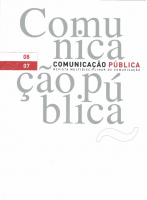The value of relationships
DOI:
https://doi.org/10.4000/cp.7698Resumo
This paper outlines concepts that explore and extend the significance of public relations as a relationship management discipline. It postulates practice through which value is created to meet organisational objectives from the known or latent potential of intangibles.
In doing so, a definition of organisations as the nexus of relationships is put forward.
The differentiation between organisational and interpersonal relationships is explored through a concept that organisational tokens are limited by the concept of materiality.
Because material value can only be released through a process of relationship change, relationship management is put forward as a management discipline that can create value. The reverse is also true. Wealth can be latent, under-exploited or destroyed when the process of relationship management acting on material tokens is not deployed to meet organisational objectives.
Downloads
Referências
Blair, M. M. (2003). Locking in capital: how corporate law made it possible for business organizers in the 19th century to build lasting institutions. UCLA Law Review 51
Bouzdine-Chameeva, T., Durrieu, F., Mandják. T.D., (2001). cognitive mapping methodology for understanding of business relationship value. http://www.impgroup.org/uploads/papers/150.pdf 2004
Bruning, S.D., Castle, J.D. & Schrepfer, E (2004) Building relationships between organizations and publics: Examining the linkage between organization‐public relationships, evaluations of satisfaction, and behavioral intent. Communication Studies, 55(3) 435-446. DOI : 10.1080/10510970409388630 good / bad
Childers Hon, L. & Grunig, J. (1999). Guidelines for measuring relationships in public relations institute for public relations. http://www.instituteforpr.com/measurement_and_evaluation.phtml?article_id=1999_guide_measure_relationships December 2004
CIPR (2003). Unlocking the potential of public relations: Developing good practice. http://www.ipr.org.uk/unlockpr/UnlockingPotential-Report.pdf
Coase. R., (1937). The nature of the firm. 4 ECONOMICA. DOI : 10.1111/j.1468-0335.1937.tb00002.x good / bad
Corrado, C., Sichel, D., & Hulten, C. (2002). Measuring capital and technology: An expanded framework. Paper presented at Conference on Research in Income and Wealth, Washington DC, 26-27 April.
Dzinkowski, R. (1999, Oct). Managing the brain trust. CMA Management, 73 (8) 14-18.
Edvinsonn, L., (2001). Interview with Leif Edvinsson: Intellectual capital: the new wealth of corporations. The new New Economy Analyst Report http://www.juergendaum.com/news/11_13_2001.htm.
Gregory, A. (2004, sep). Scope and structure of public relations: A technology driven view. Public Relations Review, 30(3) 245-254. DOI : 10.1016/j.pubrev.2004.05.001 good / bad
Gregory, A. (2005). The Message BBC 14th January 2005. http://www.bbc.co.uk/radio4/factual/rams/themessage_current.ram January 2005.
Hall, R.E. (2001, may). Struggling to understand the stock market. American Economic Review, 91(2), 1-11. DOI : 10.1257/aer.91.2.1 good / bad
Hamilton, W. D. (1964) The genetic evolution of social behaviour. Journal or Theoretical Biology, 7.
Hewitt, P (2004). Foreword to the draft regulations on the operating and financial review and directors’ report department of trade and industry. http://www.dti.gov.uk/cld/pdfs/ofr_condoc.pdf December 2004.
Jensen, M. (2001) Value maximization, stakeholder theory, and the corporate objective function tuck business school. Harvard Business School
Jeurissen, R. (2003). The institution of corporate citizenship. Paper presented at 16th Annual Conference of the European Business Ethics Network http://ethics.bkae.hu/html/documents/Jeurissenpaper.doc 2004
Jo, Hon & Brunner B. R. (2004, aug). Organisation–public relationships: Measurement validation in a university setting. Journal of Communication Management, 9(1). DOI : 10.1108/13632540510621434 good / bad
Kitchen, P.J. (1997). The Evolution of Public Relations. In public relations: Principles and practice (22-42). London: International Thomson Business Press.
Lakoff, G. (1993).The contemporary theory of metaphor. In A. Ortony (Ed.),Metaphor and Thought (pp. 202-251). New York, NY: Cambridge University Press.
Ledingham, J.A. & Bruning, S. (Eds.) (2000). Public relations as relationship management: a relational approach to the study and practice of public relations. Mahwah, N.J.: Lawrence Erlbaum Associates, Inc.
Lev, B. (2001). Intangibles: management, measurement and reporting. Washington, WA: The Brookings Institution Press,
Peirce, C.S., Hartshorne,C., Weiss, P., &Burks, A.W. (eds.) (1931-58). Collected papers of Charles Sanders Peirce (8 vols). Cambridge, MA: Harvard University Press.
Phillips, D. (2001). Online public relations. London: Kogan Page.
Roberts, H., Bronn, P.S., & Breuni, K.J. (2003). Intangible Assets and Communication. IABC Research Foundation http://www.iabc.com/fdtnweb/pdf/intangibleassets.pdf November 2003.
Sullivan, P.H. (2000). How to convert intangible corporate assets into market value. (pp. 238-244). New York, NY: Wiley.
Valin, J. (2004) Overview of public relations around the world and principles of modern practice remarks, Presented at APR, Fellow CPRS Chair of the Global Alliance At the CONFERP, Brasilia, October 2004 http://www.globalpr.org/news/features/overview_jv_04.pdf January 2005
Watson, T. (2003) The future of public relations. Presented to the ANZCA ’03 conference, Brisbane, Australia, July 2003.
White, J., & Murray, K. (2004) Chief executive officers’ expectations of a changing public relations practice. Prsented at Bled international research symposium http://www.bledcom.com/uploads/documents/white-murray.pdf December 2004.
Downloads
Publicado
Edição
Secção
Licença
Direitos de Autor (c) 2009 Copyright (c) 2009 Author

Este trabalho encontra-se publicado com a Licença Internacional Creative Commons Atribuição-NãoComercial 4.0.
Os conteúdos da Comunicação Pública estão licenciados com uma licença Creative Commons - Atribuição-NãoComercial 4.0 Internacional.




